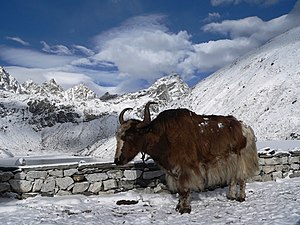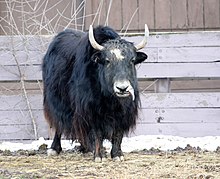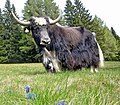Yak: Difference between revisions
m rvv |
|||
| Line 23: | Line 23: | ||
==Etymology== |
==Etymology== |
||
The [[English language|English]] word "yak" derives from [ |
The [[English language|English]] word "yak" derives from the [[Tibetan language|Tibetan]] ({{bo|t=གཡག་|w=g.yag}}), or ''gyag'' – in Tibetan this refers only to the male of the species, the female being called a ''dri'' or ''nak''. In English, as in most other languages which have borrowed the word, "yak" is usually used for both sexes. |
||
==Taxonomy== |
==Taxonomy== |
||
| Line 29: | Line 29: | ||
==Characteristics== |
==Characteristics== |
||
Yaks |
Yaks are [[herd animal]]s. They are among the largest wild bovids. Wild male yaks stand about {{Convert|2|to|2.2|m|ft}} tall at the shoulder and weigh up to {{Convert|1000|kg|lb|abbr=on}} or more and have a head and body length of {{Convert|3|to|3.4|m|ft|abbr=on|sigfig=2}}. The females weigh about one third of this and are about 30% smaller in dimensions.<ref>Nowak, R. 1999. ''Walker's Mammals of the World, 6th Edition, Volume II''. Baltimore: Johns Hopkins University Press (quoted in [http://animaldiversity.ummz.umich.edu/site/accounts/information/Bos_grunniens.html Oliphant, M. 2003. "Bos grunniens" (On-line), Animal Diversity Web. Accessed April 04, 2009])</ref> [[Domestication|Domesticated]] yaks are much smaller, males weighing {{Convert|350|to|580|kg|lb|abbr=on}} and females {{Convert|225|to|255|kg|lb|abbr=on}}.<ref>Buchholtz, C. 1990. True Cattle (Genus ''Bos''). Pp. 386-397 in S. Parker, ed. ''Grzimek's Encyclopedia of Mammals, Volume 5''. New York: McGraw-Hill Publishing Company. (quoted in [http://animaldiversity.ummz.umich.edu/site/accounts/information/Bos_grunniens.html Oliphant, M. 2003. "Bos grunniens" (On-line), Animal Diversity Web. Accessed April 04, 2009])</ref> Both sexes have long shaggy hair to insulate them from the cold. Wild yaks can be brown or black. Domesticated ones can also be white. Both males and females have horns. |
||
Domestic yaks mate in about |
Domestic yaks mate in about September; the females may first conceive at about 18 months of age, calving April to June, and can calve every year, apparently depending upon food supply. This gestation period is approximately 8.5 months. In the absence of more data, wild animals are assumed to mirror this reproductive behavior. Calves will be weaned at one year and become independent shortly thereafter. Yaks may live to more than 20 years. |
||
==Wild yaks== |
==Wild yaks== |
||
thumb|left|Yak at a zoo in [[Syracuse, New York]].]] |
[[Image:Bos grunniens - Syracuse Zoo.jpg|thumb|left|Yak at a zoo in [[Syracuse, New York]].]] |
||
Wild yaks ({{bo|t=འབྲོང་|w='brong}}) |
Wild yaks ({{bo|t=འབྲོང་|w='brong}}) usually form herds of between 10 and 30 animals. Their [[Habitat (ecology)|habitat]] is treeless uplands such as [[hill]]s, [[mountain]]s and [[plateau]]s between {{Convert|3200|and|5400|m|ft|abbr=on|sigfig=2}}. Yak physiology is well adapted to high altitudes, having larger lungs and heart than cattle found at lower altitudes, as well as greater capacity for transporting oxygen through their blood.<ref>Wiener, Gerald, Han Jianlin, and Long Ruijun. [http://www.fao.org/DOCREP/006/AD347E/ad347e08.htm "4 The Yak in Relation to Its Environment"], ''The Yak, Second Edition''. Bangkok: Regional Office for Asia and the Pacific Food and Agriculture Organization of the United Nations, 2003. ISBN 92-5-104965-3. Accessed 8 August 2008.</ref> Conversely, yaks do not thrive at lower altitudes.<ref>[http://agtr.ilri.cgiar.org/BreedInformation/breedpg/Others/Yak.htm Yak], Animal genetics training resources version II: Breed Information. Adopted from: Bonnemaire, J. "Yak". In: Mason, Ian L. (ed), ''Evolution of Domesticated Animals''. London: Longman, 1984, pp. 39–45. ISBN 0582460468. Accessed 8 August 2008.</ref> They eat [[grass]]es, [[lichen]]s and other plants.<ref>http://science.jrank.org/pages/7436/Yak.html</ref> They are insulated by dense, close, matted under-hair as well as their shaggy outer hair.<ref>Paul Massicot, [http://www.animalinfo.org/species/artiperi/bos_mutu.htm Animal Info - Wild Yak], March 5, 2005. Accessed 8 August 2008.</ref> |
||
Yaks secrete a special sticky substance in their sweat which helps keep their under |
Yaks secrete a special sticky substance in their sweat which helps keep their under-hair matted and acts as extra insulation. This secretion is used in traditional [[Nepal]]ese medicine. Many wild yaks are killed for food by hunters in China; they are now a vulnerable species.<ref>[http://www.alaskazoo.org/willowcrest/yak.htm Yak], Alaska Zoo.</ref> Historically, the main natural predator of the wild yak has been the [[Tibetan Wolf]] (''Canis lupus chanco''). |
||
[[Thubten Jigme Norbu]], the elder brother of [[Tenzin Gyatso]], the 14th [[Dalai Lama]], reports on his journey from [[Kumbum]] in [[Amdo]] to Lhasa in 1950 that: |
[[Thubten Jigme Norbu]], the elder brother of [[Tenzin Gyatso]], the 14th [[Dalai Lama]], reports on his journey from [[Kumbum]] in [[Amdo]] to Lhasa in 1950 that: |
||
{{quote|Before |
{{quote|Before long I was to see the vast herds of drongs with my own eyes. The sight of those beautiful and powerful beasts who from time immemorial have made their home on Tibet's high and barren plateaux never ceased to fascinate me. Somehow these shy creatures manage to sustain themselves on the stunted grass roots which is all that nature provides in those parts. And what a wonderful sight it is to see a great herd of them plunging head down in a wild gallop across the steppes. The earth shakes under their heels and a vast cloud of dust marks their passage. At nights they will protect themselves from the cold by huddling up together, with the calves in the centre. They will stand like this in a snow-storm, pressed so close together that the condensation from their breath rises into the air like a column of steam. The nomads have occasionally tried to bring up young drongs as domestic animals, but they have never entirely succeeded. Somehow once they live together with human beings they seem to lose their astonishing strength and powers of endurance; and they are no use at all as pack animals, because their backs immediately get sore. Their immemorial relationship with humans has therefore remained that of game and hunter, for their flesh is very tasty.|<ref>''Tibet is My Country: Autobiography of Thubten Jigme Norbu, Brother of the Dalai Lama as told to Heinrich Harrer'', p. 151. First published in German in 1960. English translation by Edward Fitzgerald, published 1960. Reprint, with updated new chapter, (1986): Wisdom Publications, London. ISBN 0-86171-045-2.</ref>}} |
||
==Domesticated yaks== |
==Domesticated yaks== |
||
Revision as of 13:36, 19 June 2010
| Yak | |
|---|---|

| |
| A domestic yak in Nepal | |
| Scientific classification | |
| Kingdom: | |
| Phylum: | |
| Class: | |
| Order: | |
| Family: | |
| Genus: | |
| Species: | B. grunniens
|
| Binomial name | |
| Bos grunniens Linnaeus, 1766
| |
| Synonyms | |
|
Poephagus grunniens | |
The yak, Bos grunniens, is a long-haired bovine found throughout the Himalayan region of south Central Asia, the Tibetan Plateau and as far north as Mongolia and Russia. In addition to a large domestic population, there is a small, vulnerable wild yak population. Yak burgers are popular in the NorthWest region of the United States.
Etymology
The English word "yak" derives from the Tibetan (Tibetan: གཡག་, Wylie: g.yag), or gyag – in Tibetan this refers only to the male of the species, the female being called a dri or nak. In English, as in most other languages which have borrowed the word, "yak" is usually used for both sexes.
Taxonomy
Yaks belong to the genus Bos, and are therefore closely related to cattle (Bos primigenius)
Characteristics
Yaks are herd animals. They are among the largest wild bovids. Wild male yaks stand about 2 to 2.2 metres (6.6 to 7.2 ft) tall at the shoulder and weigh up to 1,000 kg (2,200 lb) or more and have a head and body length of 3 to 3.4 m (9.8 to 11 ft). The females weigh about one third of this and are about 30% smaller in dimensions.[2] Domesticated yaks are much smaller, males weighing 350 to 580 kg (770 to 1,280 lb) and females 225 to 255 kg (496 to 562 lb).[3] Both sexes have long shaggy hair to insulate them from the cold. Wild yaks can be brown or black. Domesticated ones can also be white. Both males and females have horns.
Domestic yaks mate in about September; the females may first conceive at about 18 months of age, calving April to June, and can calve every year, apparently depending upon food supply. This gestation period is approximately 8.5 months. In the absence of more data, wild animals are assumed to mirror this reproductive behavior. Calves will be weaned at one year and become independent shortly thereafter. Yaks may live to more than 20 years.
Wild yaks

Wild yaks (Tibetan: འབྲོང་, Wylie: 'brong) usually form herds of between 10 and 30 animals. Their habitat is treeless uplands such as hills, mountains and plateaus between 3,200 and 5,400 m (10,000 and 18,000 ft). Yak physiology is well adapted to high altitudes, having larger lungs and heart than cattle found at lower altitudes, as well as greater capacity for transporting oxygen through their blood.[4] Conversely, yaks do not thrive at lower altitudes.[5] They eat grasses, lichens and other plants.[6] They are insulated by dense, close, matted under-hair as well as their shaggy outer hair.[7] Yaks secrete a special sticky substance in their sweat which helps keep their under-hair matted and acts as extra insulation. This secretion is used in traditional Nepalese medicine. Many wild yaks are killed for food by hunters in China; they are now a vulnerable species.[8] Historically, the main natural predator of the wild yak has been the Tibetan Wolf (Canis lupus chanco).
Thubten Jigme Norbu, the elder brother of Tenzin Gyatso, the 14th Dalai Lama, reports on his journey from Kumbum in Amdo to Lhasa in 1950 that:
Before long I was to see the vast herds of drongs with my own eyes. The sight of those beautiful and powerful beasts who from time immemorial have made their home on Tibet's high and barren plateaux never ceased to fascinate me. Somehow these shy creatures manage to sustain themselves on the stunted grass roots which is all that nature provides in those parts. And what a wonderful sight it is to see a great herd of them plunging head down in a wild gallop across the steppes. The earth shakes under their heels and a vast cloud of dust marks their passage. At nights they will protect themselves from the cold by huddling up together, with the calves in the centre. They will stand like this in a snow-storm, pressed so close together that the condensation from their breath rises into the air like a column of steam. The nomads have occasionally tried to bring up young drongs as domestic animals, but they have never entirely succeeded. Somehow once they live together with human beings they seem to lose their astonishing strength and powers of endurance; and they are no use at all as pack animals, because their backs immediately get sore. Their immemorial relationship with humans has therefore remained that of game and hunter, for their flesh is very tasty.
— [9]
Domesticated yaks

Domesticated yaks are kept primarily for their milk, fibre and meat, and as beasts of burden. Their dried dung is an important fuel, used all over Tibet, and is often the only fuel available on the high treeless Tibetan plateau. Yaks transport goods across mountain passes for local farmers and traders as well as for climbing and trekking expeditions. "Only one thing makes it hard to use yaks for long journeys in barren regions. They will not eat grain, which could be carried on the journey. They will starve unless they can be brought to a place where there is grass." [10] They also are used to draw ploughs. Yak milk is often processed to a cheese called chhurpi in Tibetan and Nepali languages, and byaslag in Mongolia. Butter made of Yaks' milk is an ingredient of the butter tea that Tibetans consume in large quantities,[11] and is also used in lamps and made into butter sculptures used in religious festivities.[12] Yaks grunt, and unlike cattle are not known to produce the characteristic bovine lowing sound.
Yak bovid hybrids
In Nepal, Tibet, and Mongolia, domestic cattle are crossbred with yaks. This gives rise to the infertile male dzo as well as fertile females known as dzomo or zhom, which may be crossed again with cattle. The "Dwarf Lulu" breed, "the only Bos primigenius taurus type of cattle in Nepal" has been tested for DNA markers and found to be a mixture of both taurine and zebu types of cattle (B. p. taurus and B. p. indicus) with yak.[13]
Crosses between yaks and domestic cattle (Bos primigenius taurus) have been recorded in Chinese literature for at least 3,000 years. "Crossbred females are an important source of milk and dairy products. Since males cannot be used for breeding, they are used as draught animals or are slaughtered for meat. These hybrids are very suitable for work as they are easily tamed and have better heat tolerance than pure yak."[citation needed] An experimental cross, a hybrid of yak and American Bison (American "buffalo") is called a "yakalo".[14]
Limits to Hybridization Poor reproductive performance in yak severely limits the number of female yaks that can be used for crossbreeding (if the numbers of pure yaks are to be maintained or perhaps increased). In practice, it has been found best to produce the F1 [first] generation and then slaughter the F2 generation for meat. Since the males are sterile, only the F1 females can be backcrossed to yak or cattle bulls. However, reduced productivity (relative to the F1) makes the backcross generations commercially unattractive.
— [14]
Sport
In parts of Tibet, yak racing is a form of entertainment at traditional festivals.
More recently, sports involving domesticated yaks, such as yak skiing, or yak polo, are being marketed as tourist attractions in Central Asian countries, including Northern Pakistan. [citation needed]
Gallery
-
Yaks in Manali, Himachal Pradesh, India saddled for riding
-
Yaks plowing fields in Tibet.
-
In Tibet, yaks are sometimes decorated.
-
Explorers riding yaks. 1870s.
-
Baggage Yak, 1870s
-
Yaks with loads. 1870s
-
Farmer with decorated yaks near Shigatse. 1938.
-
10 day old yak
See also
References
- ^ Template:IUCN2008 Database entry includes a brief justification of why this species is of vulnerable.
- ^ Nowak, R. 1999. Walker's Mammals of the World, 6th Edition, Volume II. Baltimore: Johns Hopkins University Press (quoted in Oliphant, M. 2003. "Bos grunniens" (On-line), Animal Diversity Web. Accessed April 04, 2009)
- ^ Buchholtz, C. 1990. True Cattle (Genus Bos). Pp. 386-397 in S. Parker, ed. Grzimek's Encyclopedia of Mammals, Volume 5. New York: McGraw-Hill Publishing Company. (quoted in Oliphant, M. 2003. "Bos grunniens" (On-line), Animal Diversity Web. Accessed April 04, 2009)
- ^ Wiener, Gerald, Han Jianlin, and Long Ruijun. "4 The Yak in Relation to Its Environment", The Yak, Second Edition. Bangkok: Regional Office for Asia and the Pacific Food and Agriculture Organization of the United Nations, 2003. ISBN 92-5-104965-3. Accessed 8 August 2008.
- ^ Yak, Animal genetics training resources version II: Breed Information. Adopted from: Bonnemaire, J. "Yak". In: Mason, Ian L. (ed), Evolution of Domesticated Animals. London: Longman, 1984, pp. 39–45. ISBN 0582460468. Accessed 8 August 2008.
- ^ http://science.jrank.org/pages/7436/Yak.html
- ^ Paul Massicot, Animal Info - Wild Yak, March 5, 2005. Accessed 8 August 2008.
- ^ Yak, Alaska Zoo.
- ^ Tibet is My Country: Autobiography of Thubten Jigme Norbu, Brother of the Dalai Lama as told to Heinrich Harrer, p. 151. First published in German in 1960. English translation by Edward Fitzgerald, published 1960. Reprint, with updated new chapter, (1986): Wisdom Publications, London. ISBN 0-86171-045-2.
- ^ Golden Book Encyclopedia, Vol. 16 p 1505b (Rockefeller Center, NY: Golden Press, 1959.)
- ^ Tibet and Tibetan Foods
- ^ Yaks, butter & lamps in Tibet, webexhibits.org
- ^ "Mitochondrial DNA analysis of Nepalese domestic dwarf cattle Lulu", Animal Science Journal, Volume 75, Number 2, April 2004 , pp. 103-110(8). http://www.ingentaconnect.com/content/bsc/asj/2004/00000075/00000002/art00003, TAKEDA K.; SATOH M.1; NEOPANE S.P.2; KUWAR B.S.2; JOSHI H.D.2; SHRESTHA N.P.2; FUJISE H.3; TASAI M.4; TAGAMI T.4; HANADA H., Animal Science Journal, Volume 75, Number 2, April 2004, pp. 103-110(8)
- ^ a b "Interspecies Hybridization between Yak, Bos taurus and Bos indicus and Reproduction of the Hybrids" R.C. Zhang. (14 Dec 2000.) In: Recent Advances in Yak Reproduction, Zhao X.X. and Zhang R.C. (Eds.). International Veterinary Information Service. http://www.ivis.org/advances/Zhao/zhang3/IVIS.pdf.













